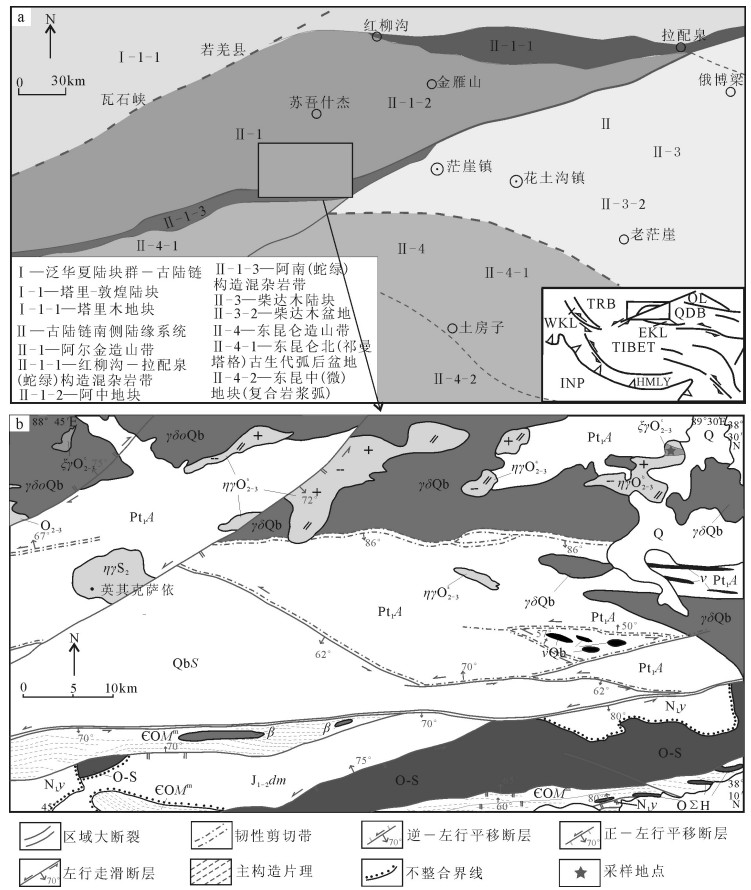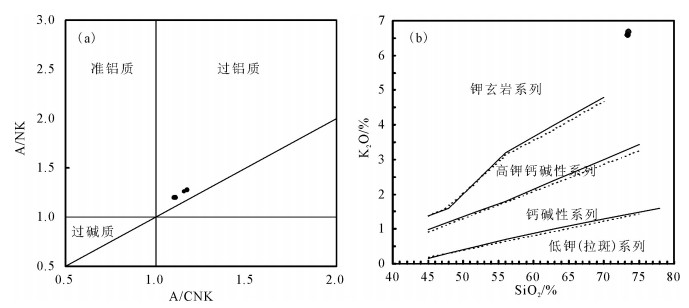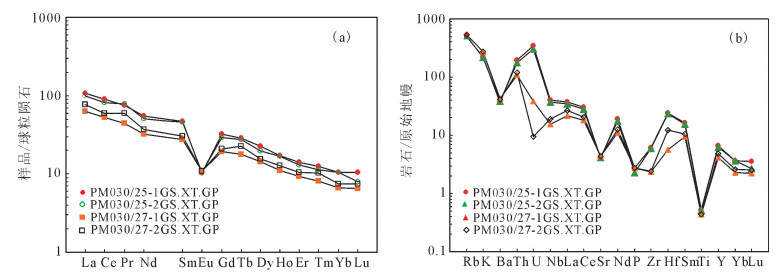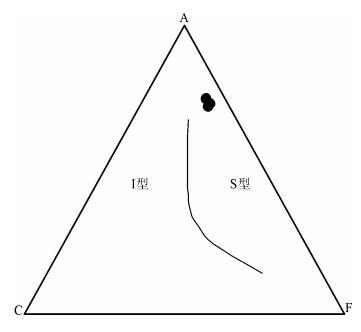The discovery of Middle-Late Ordovician syenogranite on the southern margin of Altun orogenic belt and its geological significance
-
摘要:
出露于阿尔金造山带帕夏拉依档沟一带的正长花岗岩,LA-ICP-MS锆石U-Pb测年结果显示其形成年龄为455.1±3.6Ma,属中―晚奥陶世。地球化学结果显示,主量元素具有富硅、富铝、富钾,低钛、贫钙、贫镁的特点,为强过铝质花岗岩系列,具高钾钙碱性特征。稀土元素总量较高,轻稀土元素富集、重稀土元素亏损,稀土元素球粒陨石标准化配分曲线有右倾型特征和明显的负Eu异常,与典型壳源花岗岩配分曲线一致。Ba、Sr、Ti等具负异常,Rb、Th、K等大离子亲石元素具正异常,显示S型花岗岩特征。结合原岩判别图解,推断其源区物质主要来源于上地壳变泥质沉积岩类。结合区域资料,认为正长花岗岩形成于挤压体制向拉张体制转换的构造环境,属后碰撞花岗岩类,表明在中―晚奥陶世阿中地块和柴达木地块已由挤压碰撞阶段转为伸展后碰撞阶段。
-
关键词:
- 阿尔金造山带 /
- LA-ICP-MS锆石U-Pb测年 /
- 正长花岗岩 /
- 地球化学 /
- 岩石成因
Abstract:The syenogranite is located in the Paxialayidang ditch of the Altun Mountains. The U-Pb dating of zircons from the syenogranite using LA-ICP-MS yielded a group age of 455.1±3.6Ma, indicating that the crystallization of the intrusion occurred in Middle-Late Ordovician period. The geochemical analysis shows that major elements are characterized by high SiO2, Al2O3 and K2O and low TiO2, CaO and MgO, which suggests that syenogranite belongs to the typical high-K calc-alkaline series with deeply peraluminous feature. In addition, the rocks are enriched in total REE. The samples are enriched in LREE (light rare earth elements) and depleted in HREE (heavy rare earth elements) with Eu anomalies. The chondrite-normalized REE patterns show right-oblique type. The syenogranite is enriched in large ion lithophile elements of Rb, Th, K and depleted in high field strength elements of Ba, Sr, Ti, with the characteristics of S-type granite. In combination with the diagrams for discriminating compositions of original rocks, the authors hold that the rocks were formed by the partial melting of meta-pelitic sedimentary rocks from the lower crust. Combined with the data of regional geological characteristics, the authors consider that the syenogranite was formed in the transitional tectonic setting from the compressional to the extensional regime, thus belonging to the post-collisional granites. It is shown that Azhong Block and Qaidam Block entered into a transformation period from compression to extension during Middle-Late Ordovician period.
-
Keywords:
- Altun orogenic belt /
- LA-ICP-MS zircon U-Pb dating /
- syenogranite /
- geochemistry /
- petrogenesis
-
阿尔金造山带位于青藏高原东北部边缘,介于塔里木板块、柴达木微板块及祁连、东昆仑造山带之间,处于古特提斯洋盆(双湖带、南羌塘、班怒带)北部大陆边缘。阿尔金构造带是中—新生代以来强烈活动的左行走滑断裂带为青藏高原北部一条重要的应力释放线[1-2]。根据校培喜等[2]的划分方案,将阿尔金造山带自北向南划分为红柳沟-拉配泉(蛇绿)构造混杂岩带、阿中地块、阿南(蛇绿)构造混杂岩带。研究区位于阿尔金造山带南缘,以阿尔金南缘主断裂为界,可进一步划分为阿中地块和阿南(蛇绿)构造混杂岩带,本次研究的中—晚奥陶世正长花岗岩出露于阿中地块(图 1)。
![]() 图 1 阿尔金造山带地质构造图(a)及研究区地质简图(b, 据参考文献①修改)TRB—塔里木盆地;QL—祁连山;QDB—柴达木盆地;WKL—西昆仑;EKL—东昆仑;HMLY—喜马拉雅山;INP—印度板块;Q—第四系;N2y—新近系油砂山组;J1—2dm—侏罗系大煤沟组;
图 1 阿尔金造山带地质构造图(a)及研究区地质简图(b, 据参考文献①修改)TRB—塔里木盆地;QL—祁连山;QDB—柴达木盆地;WKL—西昆仑;EKL—东昆仑;HMLY—喜马拉雅山;INP—印度板块;Q—第四系;N2y—新近系油砂山组;J1—2dm—侏罗系大煤沟组;阿尔金造山带南缘广泛出露早古生代岩浆岩,作为阿尔金造山带南缘构造演化过程的岩浆响应,是研究揭示阿尔金南缘陆壳深俯冲作用及折返演化过程的线索。然而,前人对早古生代花岗岩的形成环境还存在争议。阿中地块发育大规模的早古生代岩浆岩,北东东向展布,与区域主构造方向一致,岩体变形较弱,部分岩体发育片麻理,主要由钾长花岗岩、二长花岗岩、黑云母花岗岩、片麻状花岗岩等构成,大多与围岩呈侵入接触关系,局部为断层或韧性剪切带接触。其中,江尕勒萨依黑云母花岗岩主要组成矿物为钾长石(30%~40%)、斜长石(20%~30%)、石英(20%~25%)、黑云母(10%~15%);若羌河片麻状花岗岩的主要组成矿物为钾长石(35%~40%)、斜长石(20%~25%)、黑云母(15%~20%)、白云母(10%~15%)和石英(10%~15%)。锆石U-Pb定年显示,吐拉、江尕勒萨依、迪木那里克、瓦石峡、若羌河和茫崖花岗岩的年龄分别为453.4± 2.5Ma、453.1 ± 2.1Ma、452.8 ± 3.1Ma、462 ± 2Ma、454.0±1.8Ma和451±1.7Ma[3-5],反映了南阿尔金地区早古生代区域性壳源花岗质岩浆和幔源基性岩浆侵入的构造岩浆热事件。
茫崖镇北石英闪长岩和阿卡龙山花岗岩的SHRIMP锆石U-Pb定年结果显示,其形成年龄分别为466±5Ma和469±6Ma,二者均具有岛弧火成岩的地球化学属性,其形成可能与洋壳的俯冲作用有关[6]。玉苏普阿勒克塔格岩体中花岗细晶岩和寄主花岗岩的形成时代分别为406Ma和424Ma,表明阿尔金南缘在早古生代末期存在造山后伸展背景下的幔源岩浆底侵作用[7];塔特勒克布拉克复式花岗岩体被认为形成于俯冲碰撞造山后抬升阶段,451± 1.7Ma和462±2Ma的年龄对应于区内深俯冲陆壳的折返时代[3-4];阿尔金造山带南缘在约500Ma时发生了以超高压岩石为代表的陆壳深俯冲-碰撞事件,同时在约450Ma发生了陆壳深俯冲/折返事件[5]。可见,早古生代花岗岩形成的构造环境存在争议。
因此,本文选取帕夏拉依档岩体中新发现的肉红色正长花岗岩为研究对象,结合野外考察,基于岩相学、LA-ICP-MS锆石U-Pb定年和地球化学研究,确定其形成年代、岩石成因及构造环境,同时对比阿尔金造山带南、北缘岩浆响应,为早古生代构造演化过程提供新证据。
1. 区域地质背景及岩石学特征
帕夏拉依档岩体前人解体出二长花岗岩(ηγO2-3a)和偶含斑二长花岗岩(ηγO2-3b) 2个侵入体,本次新发现的肉红色正长花岗岩(ξγO2-3c)分布于研究区北部,出露于古—中元古代结晶基底中,多呈岩滴产出,出露面积较小。正长花岗岩的围岩有中—晚奥陶世浅灰色二长花岗岩(ηγO2-3a)、古元古界阿尔金岩群和青白口纪盖里克片麻岩(γδQb)。中—晚奥陶世浅灰色二长花岗岩形成年龄为460.1±3.9Ma,形成于挤压体制向拉张体制转换的构造环境[8];阿尔金岩群属变质结晶基底,为一套浅海相碎屑岩-火山岩-碳酸盐岩建造;盖里克片麻岩岩性主要由眼球状黑云斜长片麻岩、二云二长片麻岩组成,原岩为斜长花岗岩、黑云母花岗岩,LA-ICP-MS锆石U-Pb定年结果显示形成年龄为886.5±5Ma,形成于同碰撞构造环境,可能对应于新元古代的罗迪尼亚(Rodinia)超大陆汇聚事件[9]。
本次新发现的正长花岗岩,与中—晚奥陶世浅灰色二长花岗岩(ηγO2-3a)呈脉动接触关系(图版Ⅰ-a、b),并侵入于下元古界阿尔金岩群a岩组和青白口纪盖里克片麻岩(γδQb)中,其中可见大量围岩的捕虏体(图版Ⅰ-c),在遥感影像上其与围岩的界线也非常清楚(图版Ⅰ-d)。其岩石学特征如下。
正长花岗岩,呈肉红色,具花岗结构,主要由石英(25%)、斜长石(15%)和碱性长石(56%)组成,含有少量绿泥石(3%),大部分为中粒,粒径2.00~4.00mm,少量为细粒,粒径0.50~2.00mm。石英呈他形粒状,表面干净,具波状消光,部分表面有裂纹,石英具动态重结晶,呈锯齿状镶嵌。斜长石呈他形板状,表面污浊,绢云母化、粘土化,可见聚片双晶和卡钠复合双晶。碱性长石呈他形板状和粒状,大部分为条纹长石,少量为格子双晶状的微斜长石,部分表面污浊,粘土化。绿泥石呈片状,具靛蓝和紫色异常干涉色。金属矿物呈他形粒状,散点状分布。
2. 分析方法
2.1 锆石U-Pb同位素分析方法
在中―晚奥陶世正长花岗岩中采集锆石U-Pb定年样品1件,样品编号为PM030/25-1,岩性为正长花岗岩,测年样品采样点坐标:北纬38°27′10″、东经89°26′46″,高程3460m。采集样品约15kg,在核工业二〇三研究所采用常规方法进行粉碎,并用浮选和电磁选方法进行分选,然后在西北大学大陆动力学国家重点实验室双目镜下挑选出晶形和透明度较好的锆石颗粒,将它们粘贴在环氧树脂表面,待环氧树脂充分固化后,再对其进行抛光至锆石内部暴露。在西北大学大陆动力学国家重点实验室进行反射光、透射光和阴极发光(CL)显微照相,锆石的CL图像分析在装有英国Gatan公司生产的Mono CL3+阴极发光装置系统的电子显微扫描电镜上完成。通过对反射光、透射光和阴极发光图像分析,选择吸收程度均匀和形态明显不同的区域进行分析。锆石微量元素分析在西北大学大陆动力学国家重点实验室的LA-ICP-MS仪器上用标准测定程序进行。分析仪器为美国Agilent公司生产的Agilent7500a型四极杆质谱仪和德国Microlas公司生产的Geolas200M型激光剥蚀系统,激光器为193nm深紫外ArF准分子激光器,激光波长为193nm,束斑直径为30μm,频率为8Hz,能量为70mJ,采样方式为单点剥蚀, 每个分析点的气体背景采集时间为30s,信号采集时间为40s;用美国国家标准人工合成硅酸盐玻璃标准参考物质NIST SRM 610进行仪器最佳化调试,数据采集选用质量峰采点的跳峰方式,每完成6个待测样品测定,插入测标样1次。锆石年龄计算采用标准锆石91500作为外标,元素含量采用美国国家标准物质局人工合成硅酸盐玻璃NISTSRM610作为外标,29Si作为内标元素进行校正。数据采集处理采用Glitter(Version4.0, Mcquaire University),并采用Anderson软件[10]对测试数据进行普通铅校正,年龄计算及谐和图绘制采用Isoplot(3.0版)软件[11]完成。详细的实验原理和流程及仪器参见Yuan等[12]。
2.2 元素分析方法
主量、微量和稀土元素检测分析由核工业二〇三研究所分析测试中心完成。FeO采用容量法分析,依据标准GB/T14506.14—2010;其余主量元素、TFe2O3和微量元素中P、Ba、V、Cr、Rb、Sr、Zr、Sc均采用XRF法分析,使用仪器为荷兰帕纳科公司制造的Axios X射线光谱仪,依据标准GB/T14506.28—2010;所有稀土及微量元素中Co、Ni、Nb、Hf、Ta、Th、U采用ICP-MS法分析,使用仪器为Thermo Fisher Scientific公司制造的XSERIES2型ICP-MS,依据标准GB/T14506.30—2010;TFe2O3值通过计算公式TFe2O3=Fe2O3+FeO×1.1113得出。主量元素分析数据中烧失量值介于0.40%~0.66%之间,总量在99.05%~99.93%之间,满足精度标准要求;主量元素分析误差小于1%,微量和稀土元素分析精度优于5%。
3. LA-ICP-MS锆石U-Pb定年结果
用于锆石U-Pb同位素测定的样品采自中—晚奥陶世正长花岗岩(PM030/25-1)。锆石CL图像(图 2)显示其颗粒粗大,多为浅黄色-无色透明,晶形较好,以长柱状为主,粒径为100~500μm,长宽比为1.5:1~5:1。CL图像显示,部分锆石环带特征不明显,部分具有弱的环带特征,整体发暗,可能主要是锆石的U、Th、稀土元素含量较高造成的。
对正长花岗岩样品PM030/25-1的18粒锆石进行了18个点的测试,分析结果见表 1。锆石的Th、U含量分别为26.49×10-6~189.53×10-6、3036.06×10-6~12768.64×10-6,除点5、7、11和18外,其余14个测点的数据明显组成一个年龄密集区(图 3;表 1),206Pb/238U年龄值集中在448± 7~459±7Ma之间,年龄加权平均值为455.1± 3.6Ma(MSWD=0.13),所以455.1±3.6Ma的年龄值可以代表帕夏拉依档岩体正长花岗岩的侵位年龄。另外,测点5和7的206Pb/238U年龄值均为424±6Ma。测点11和18的206Pb/238U年龄值分别为391±6Ma和395±6Ma。打点位置均位于锆石边部,代表中—晚奥陶世正长花岗岩分别经历了晚志留世和早三叠世的热事件改造。
表 1 正长花岗岩(PM030-25) LA-ICP-MS锆石U-Th-Pb同位素分析结果Table 1. LA-ICP-MS zircon U-Th-Pb isotopic analyses of the syenogranite(PM030/25-1)点号 同位素比值 年龄/Ma 207Pb/206Pb 207Pb/235U 206Pb/238U 208Pb/232Th 207Pb/206U 207Pb/235U 206Pb/238Th 208Pb/232Th 比值 误差
(1σ)比值 误差
(1σ)比值 误差
(1σ)比值 误差
(1σ)年龄 误差
(1σ)年龄 误差
(1σ)年龄 误差
(1σ)年龄 误差
(1σ)01 0.05707 0.00171 0.57749 0.00941 0.07342 0.00112 0.05629 0.0011 494 65 463 6 457 7 1107 21 02 0.05687 0.00168 0.57305 0.00885 0.0731 0.00111 0.07703 0.00145 486 65 460 6 455 7 1500 27 03 0.05535 0.00164 0.55877 0.00869 0.07323 0.00112 0.02783 0.00069 426 64 451 6 456 7 555 14 04 0.05688 0.00174 0.57085 0.00989 0.0728 0.00113 0.05736 0.00174 486 67 459 6 453 7 1127 33 05 0.06285 0.00188 0.58845 0.00961 0.06792 0.00105 0.14796 0.00256 703 63 470 6 424 6 2789 45 06 0.0543 0.0016 0.54623 0.00841 0.07297 0.00112 0.0405 0.00066 383 65 443 6 454 7 803 13 07 0.07356 0.00224 0.68855 0.0118 0.0679 0.00106 0.27561 0.00532 1029 60 532 7 424 6 4920 84 08 0.05507 0.00162 0.55805 0.00866 0.0735 0.00114 0.04739 0.00075 415 64 450 6 457 7 936 15 09 0.0534 0.00173 0.52987 0.01078 0.07197 0.00114 0.0417 0.00171 346 72 432 7 448 7 826 33 10 0.05618 0.00166 0.56795 0.00899 0.07332 0.00114 0.04302 0.00086 459 65 457 6 456 7 851 17 11 0.08164 0.0024 0.70473 0.01088 0.0626 0.00098 0.37524 0.00498 1237 56 542 6 391 6 6440 73 12 0.05635 0.00166 0.56979 0.00893 0.07332 0.00115 0.06536 0.00104 466 64 458 6 456 7 1280 20 13 0.05457 0.00161 0.55501 0.0087 0.07375 0.00116 0.06298 0.00094 395 64 448 6 459 7 1235 18 14 0.05535 0.00163 0.55715 0.00873 0.07298 0.00115 0.06047 0.00084 426 64 450 6 454 7 1187 16 15 0.05469 0.00161 0.55186 0.00871 0.07316 0.00116 0.02667 0.00039 400 63 446 6 455 7 532 8 16 0.05455 0.00161 0.55219 0.00877 0.07339 0.00117 0.03629 0.00059 394 64 446 6 457 7 721 12 17 0.05348 0.00158 0.54063 0.00861 0.07329 0.00117 0.02897 0.00048 349 65 439 6 456 7 577 9 18 0.0608 0.00179 0.52975 0.00842 0.06316 0.00101 0.11114 0.00152 632 62 432 6 395 6 2130 28 4. 岩石地球化学特征
中―晚奥陶世正长花岗岩的主量、微量及稀土元素测试结果见表 2。
表 2 中―晚奥陶世正长花岗岩主量、微量和稀土元素分析结果Table 2. Major, trace and rare earth elements analyses of the syenogranite in Middle-Late Ordovician period样号 PM030/25-1 PM030/25-2 PM030/27-1 PM030/27-2 SiO2 73.53 73.49 72.15 72.21 TiO2 0.14 0.15 0.11 0.13 Al2O3 13.96 13.68 14.49 14.52 Fe2O3 0.68 0.70 0.65 0.65 FeO 0.76 0.72 0.86 0.85 MnO 0.02 0.02 0.02 0.02 MgO 0.32 0.30 0.29 0.29 CaO 0.52 0.51 0.55 0.50 Na2O 2.36 2.18 1.99 2.01 K2O 6.68 6.59 8.20 8.17 P2O5 0.06 0.05 0.06 0.06 烧失量 0.54 0.66 0.40 0.52 总计 99.57 99.05 99.77 99.93 σ 2.68 2.52 3.56 3.55 K2O/Na2O 2.83 3.02 4.12 4.06 AR 1.97 1.89 1.72 1.73 SI 2.96 2.86 2.42 2.42 FL 94.56 94.50 94.88 95.32 MF 81.77 82.56 83.93 83.84 R1 2455.31 2537.80 2138.28 2141.96 R2 345.35 337.79 357.47 352.70 AIK 0.80 0.78 0.84 0.84 A/CNK 1.16 1.17 1.10 1.11 K2O+Na2O 9.04 8.77 10.19 10.18 Na2O/K2O 0.35 0.33 0.24 0.25 m/f 0.41 0.39 0.35 0.35 La 25.4 23.66 15.1 18.23 Ce 54.6 50.38 32.3 36.66 Pr 7.23 7.42 4.22 5.64 Nd 25.8 23.66 15.1 17.23 Sm 7.17 6.98 4.24 4.67 Eu 0.598 0.61 0.635 0.63 Gd 6.66 5.99 4 4.26 Tb 1.08 1.02 0.665 0.85 Dy 5.77 4.99 3.68 3.95 Ho 0.966 0.95 0.632 0.72 Er 2.33 2.16 1.53 1.73 Tm 0.318 0.29 0.208 0.26 Yb 1.78 1.78 1.14 1.28 Lu 0.264 0.2 0.164 0.19 Y 30.2 28.76 19.1 21.93 ∑REE 170.17 158.85 102.71 118.23 LREE 120.80 112.71 71.60 83.06 HREE 49.37 46.14 31.12 35.17 LREE/HREE 2.45 2.44 2.30 2.36 δEu 0.26 0.28 0.46 0.42 δCe 0.94 0.89 0.94 0.84 (La/Yb)N 9.64 8.98 8.95 9.62 (La/Sm)N 2.23 2.13 2.24 2.46 (Gd/Yb)N 3.03 2.73 2.84 2.70 Cu 14.10 13.99 13.50 13.65 Pb 66.90 66.40 65.80 66.10 Zn 35.50 34.60 26.00 28.20 Co 1.88 1.94 2.59 2.42 Ni 2.13 2.45 3.57 3.31 Cr 17.10 16.96 15.30 16.10 V 6.60 8.20 11.90 10.30 Ga 17.20 17.10 16.20 16.80 Sr 86.10 88.20 92.30 91.40 Ba 255.70 266.00 295.80 289.00 Rb 319.20 327.00 339.50 338.00 Nb 28.70 26.80 11.10 13.70 Ta 3.42 3.32 0.94 1.45 Zr 67.80 65.90 26.40 27.10 Hf 7.46 7.32 1.77 1.89 U 7.23 7.13 6.40 6.41 Th 16.70 15.10 9.24 10.30 Ag 0.03 0.03 0.04 0.04 Au/10-9 3.17 3.16 3.12 3.16 Cs 7.47 7.58 7.87 7.79 Mg# 29.43 28.37 26.30 26.43 Rb/Sr 3.71 3.71 3.68 3.70 K/Rb 173.65 167.23 200.42 200.57 Ba/Sr 2.97 3.02 3.20 3.16 Th/Ta 4.88 4.55 9.82 7.10 K 55429.79 54682.98 68042.55 67793.62 注:主量元素含量单位为%,微量和稀土元素含量为10-6 4.1 主量元素
正长花岗岩SiO2含量较高(平均72.85%),变化范围不大(72.15%~73.53%),属于酸性岩浆岩;富钾(K2O=6.59%~8.20%,平均7.41%;K2O/Na2O= 2.83~4.12);富碱(K2O+Na2O=8.77%~10.19%,平均9.55%);低P2O5(0.05%~0.06%,平均0.06%)、Na2O (1.99%~2.36%,平均2.14%)、MgO(0.29%~0.32%,平均0.30%);贫钙CaO(0.50%~0.55%,平均0.52%)和低钛TiO2(0.11%~0.15%,平均0.13%)含量的特征。TFeO含量在1.35% ~1.45%之间,平均为1.40%;岩石铝含量较高(Al2O3=13.68%~14.52%,平均14.16%),铝饱和指数(A/CNK)介于1.10~1.17之间,均大于1.1,A/NK>1,在A/CNK- A/NK图解上样品全部落入过铝质花岗岩区域(图 4-a),为强过铝质系列;岩石的碱度率指数AR为4.24~5.21,具有富铝的特点;里特曼指数σ为2.52~3.56,平均为3.08,小于3.3,属钙碱性。岩石中K2O含量较高,在SiO2-K2O图解(图 4-b)上,表现出钾玄岩系列岩石特征,暗示原始岩浆富钾,花岗岩源岩具有壳源的特点,说明岩石属铝和硅过饱和类型。上述特征表明,阿尔金帕夏拉依档岩体具有富硅、铝、钾,贫铁、镁的特点,总体显示偏过铝钾(碱)质花岗岩的特征。
4.2 稀土和微量元素
正长花岗岩稀土元素总量∑REE=102.71×10-6~170.17×10-6,平均为137.49×10-6,轻、重稀土元素比值较高(∑LREE/∑HREE=2.30~2.45,平均值为2.39)。轻稀土元素相对富集且分异较弱[(La/Sm)N= 2.13~2.46],重稀土元素相对亏损且发生分异[(Ga/Yb)N=2.69~3.02],轻、重稀土元素分异明显[(La/Yb)N= 8.93~9.62];δEu=0.26~0.46,平均值为0.36,显示明显的负Eu异常,暗示岩浆在形成过程中可能存在斜长石的分离结晶作用或部分熔融过程中源区有斜长石的残留。稀土元素球粒陨石标准化分布型式图显示轻稀土元素富集、重稀土元素亏损的右倾型分布模式(图 5-a),指示其为壳源型花岗岩。
![]() 图 5 中―晚奥陶世正长花岗岩球粒陨石标准化稀土元素分布型式(a)和原始地幔标准化微量元素蛛网图(b) [15]Figure 5. Chondrite-normalized REE patterns(a) and primitive mantle-normalized trace element patterns (b) of the syenogranite in Middle-Late Ordovician period
图 5 中―晚奥陶世正长花岗岩球粒陨石标准化稀土元素分布型式(a)和原始地幔标准化微量元素蛛网图(b) [15]Figure 5. Chondrite-normalized REE patterns(a) and primitive mantle-normalized trace element patterns (b) of the syenogranite in Middle-Late Ordovician period在微量元素原始地幔标准化蛛网图(图 5-b)上,正长花岗岩富集Rb、Th、K等大离子亲石元素(LILE)和La、Ce、Nd等轻稀土元素,Ba、Sr、Ti明显亏损;具有明显的Ba和Sr负异常,Zr和Hf无明显分异,Ba、Sr、P亏损和负Eu异常,充分指示成岩过程中存在斜长石、磷灰石、钛铁矿等的分离结晶作用。
5. 讨论
5.1 岩石成因
研究区缺乏与中―晚奥陶世正长花岗岩同时代大面积的基性岩浆的出露,且岩石的Nb/Ta值为8.07~11.80,平均值为9.43,接近于地壳平均值(12~13),Nb、Ta的亏损反映了岩浆源区具有壳源物质成分。Cr、Ni含量很低,分别为15.3×10-6~17.10×10-6(平均为16.37×10-6)和2.13×10-6~3.57×10-6(平均为2.87×10-6),说明其由富集的幔源岩浆受到地壳混染形成的可能性很小。Mg#指数为26.30~29.43 (平均值为27.63),明显小于玄武岩熔融实验熔体成分的Mg#值[16],地壳部分熔融形成的熔体不管熔融程度如何,形成的岩石均具有较低的Mg#值(<40)。以上特征也说明,中―晚奥陶世正长花岗岩与地壳物质部分熔融有关。在(Na2O + K2O)- 10000Ga/Al和Nb- 10000Ga/Al图解[17-18](图 6)中,样品点都投在I & S型花岗岩范围。在ACF图解(图 7)中,样品点全部投影在S型花岗岩区域。S型花岗岩岩浆起源于大陆地壳中沉积的源岩,Rb/Sr值能灵敏地记录源区物质的性质,当Rb/Sr<0.9时,为I型花岗岩;Rb/Sr>0.9时,为S型花岗岩。正长花岗岩Rb/Sr=3.68~3.71,显示S型花岗岩特征。岩石的10000Ga/Al值(2.11~2.36,平均值为2.25),接近S型花岗岩的平均值(2.28) [17]。因此,中―晚奥陶世正长花岗岩属于S型花岗岩,是地壳物质熔融的产物[19]。
中―晚奥陶世正长花岗岩具有铝过饱和(A/CNK=1.10~1.17)且富钾(K2O=6.59%~8.20%,平均7.41%)的特点。正长花岗岩的CaO/Na2O值介于0.22~0.28之间(平均值为0.24),暗示源区为泥质岩。在Rb/Sr-Rb/Ba图解(图 8)中,样品点全部分布在粘土岩源区,表明其源岩主要为地壳泥质岩沉积物。
在阿尔金造山带南缘,早古生代岩浆岩以高温低压岩浆活动为特征,并发育花岗岩,这与板片拆离后同折返阶段的岩浆岩组合和岩石成因一致[20]。在板片拆离和地壳折返过程中,下地壳岩石往往不发生抬升折返,这是因为地壳主要由密度较小的长英质岩石组成,而下地壳主要由密度较大的镁铁质岩石组成所致[21-23],造成阿尔金南缘在该阶段发生以上地壳物质为主的减压熔融作用。因此,中―晚奥陶世肉红色正长花岗岩是上地壳变质泥质岩系部分熔融的产物。
5.2 构造环境
中―晚奥陶世肉红色正长花岗岩变形变质较弱,其时代与高压麻粒岩相的退变质年代455Ma吻合,说明在此阶段俯冲板片可能已经拆离,导致物质折返[5]。
正长花岗岩铝饱和指数(A/CNK)介于1.10~1.17之间,稀土元素总量高,轻稀土元素富集,Eu强烈负异常,反映其岩浆来源于地壳增厚重熔作用,高钾钙碱性和钾玄岩系列被认为是大陆碰撞造山带的典型组合。在构造环境判别(Y+Nb) -Rb图解(图 9-a)中,2个样品点落入同碰撞花岗岩区域,2个样品点落入同碰撞花岗岩和板内花岗岩相交区域;在(Yb+Ta) -Rb图解(图 9-b)中,样品点全部落入同碰撞花岗岩区;在Yb-Ta图解(图 9-c)和Y-Nb图解(图 9-d)中,也分别有1个和2个样品点投在同碰撞花岗岩和板内花岗岩相交区域。在R1-R2图解中,样品点落入同碰撞花岗岩且靠近造山后花岗岩区域(图 10-a);在Hf-Rb/30-Ta×3三角判别图解中,2个样品点落入同碰撞花岗岩区,2个样品点投到碰撞后花岗岩区域(图 10-b)。
花岗岩类的微量和稀土元素表现为富集大离子亲石元素(LILE)和La、Ce、Nd等轻稀土元素,亏损Nb、Ta、Ti等高场强元素,也具备碰撞花岗岩的特征。
区域上,杨文强等[28]认为,南阿尔金俯冲碰撞杂岩带中早古生代花岗质岩浆活动第二期时代为466~451Ma,形成于深俯冲陆壳断离后的伸展背景。刘良等[5]认为,462~451Ma花岗岩形成于陆壳俯冲碰撞挤压向伸展抬升转换阶段。本文正长花岗岩形成时代(455.1±3.6Ma)不仅与阿尔金南缘地区代表板片拆离的高压-超高压岩石的退变质时代(445Ma)吻合,还与杨文强等[28]和刘良等[5]研究的早古生代花岗岩时代一致,应具有相同的地质构造背景,均形成于初始后碰撞伸展环境。
综上所述,中―晚奥陶世肉红色细粒正长花岗岩具有同碰撞挤压-后碰撞伸展转折环境的特征,形成于挤压体制向拉张体制转换的构造环境,属后碰撞花岗岩类。
5.3 对阿尔金造山带南缘构造演化的制约
阿尔金造山带南缘具有典型碰撞造山的特征,其主要标志为与大陆深俯冲有关的高压-超高压变质作用、中酸性侵入岩广泛发育、碰撞后伸展、垮塌作用等[29]。阿尔金南缘超高压岩石的峰期变质时代(504~486Ma) [30]与该阶段花岗岩的侵位时代(501~496Ma)基本一致。该阶段发生了碰撞造山作用,导致“南阿尔金洋盆”闭合,一直持续到茫崖二长花岗岩(472.1±1.1Ma),依旧显示阿尔金南缘为碰撞造山,伴随地壳物质发生深俯冲作用[31]。在约450Ma发生了陆壳深俯冲/折返事件,俯冲陆壳发生板片断离并开始折返,构造由碰撞挤压转换为伸展体制,导致高压-超高压变质岩石在462~451Ma发生退变质作用,并产生同折返或后碰撞花岗岩。
笔者于2016年对中—晚奥陶世二长花岗岩的研究表明,其形成时代为460.1±3.9Ma,属早古生代中—晚奥陶世,构造环境反映其具有同碰撞向后碰撞环境过渡的特征,形成于挤压体制向拉张体制转换的构造环境,属后碰撞花岗岩类[8]。本次新发现的正长花岗岩的形成时代为455.1±3.6Ma,与其具有类似的构造环境。前人在邻区也发现了大量后碰撞花岗岩的物质记录,塔特勒克布拉克二长花岗岩形成年龄为462±2Ma,形成于碰撞造山后抬升初期,即俯冲碰撞造山后应力释放的初级阶段,陆壳物质由于压力释放而部分熔融[3];塔特勒克布拉克复式花岗质岩体形成年龄为451±1.7Ma,与超高压岩石高压麻粒岩相退变质时代基本一致,该岩体形成可能是陆壳深俯冲/折返构造过程的岩浆作用响应,构造背景为碰撞造山后应力释放的伸展[4]。该时段岩浆岩的岩性较复杂,区域内,超基性-基性岩浆岩主要由辉橄岩、角闪辉长岩、辉长岩和辉绿岩组成,识别出长沙沟-清水泉镁铁-超镁铁质侵入体、长沙沟杂岩体、柴水沟辉绿岩、茫崖角闪辉长岩和长沙沟辉长岩,形成时代分别为467.4±1.4Ma[32]、458.7 ± 1.8Ma[33]、453.5 ± 3.5Ma[6]、444.9 ± 1.3Ma[34]和444.9±3.4Ma[35],上述基性-超基性岩大多与围岩呈侵入接触关系,并非蛇绿构造混杂岩带组分,岩石属于碱性岩石。前人研究成果表明,该阶段为后碰撞伸展阶段,但局部仍存在高压部分熔融特征的岩浆活动,因此该阶段应属于碰撞后伸展的初始阶段。
碰撞后伸展阶段,高压-超高压变质岩石进一步发生角闪岩相退变质作用,并产生426~385Ma的花岗质岩浆作用[5]。在本次锆石U-Pb年龄中出现了424~391Ma的年龄,反映了晚志留世和早三叠世的热事件改造。在该阶段岩浆岩发育规模较大,前人测得玉苏普阿勒克塔格岩体形成年龄为424Ma[7],吐拉花岗岩形成时间为385.2Ma[36],总体属高钾钙碱性系列,具类似“海鸥”式的A型花岗岩稀土元素配分曲线特征,结合岩浆活动以高温低压为特征,426~385Ma阶段构造环境应为后碰撞伸展拉张环境。
结合本文和前人研究成果,将阿尔金造山带南缘早古生代俯冲碰撞杂岩带的构造演化过程至少划分为3个阶段:①504~472Ma,碰撞造山的陆-陆深俯冲阶段;②462~451Ma,具板片拆离后同折返岩浆岩特征,属于初始后碰撞伸展的地壳折返阶段,本文正长花岗岩即在该阶段侵位;③424~385Ma,后碰撞伸展阶段。
6. 结论
(1) 阿尔金造山带南缘肉红色正长花岗岩LA-ICP-MS锆石U-Pb测年结果表明,其形成年龄为455.1±3.6Ma,属中—晚奥陶世。
(2) 地球化学特征表明,阿尔金造山带南缘肉红色正长花岗岩主量元素具有富硅、高铝、富碱、富钾,低钛、贫钙、贫镁的特点,为过铝质花岗岩系列,具典型的高钾钙碱性特征。稀土元素总量较高,轻稀土元素相对富集、重稀土元素亏损,有右倾型特征和明显的负Eu异常。Ba、Sr、Ti等具负异常,Rb、Th、K等大离子亲石元素具正异常,显示S型花岗岩特征。推断其源区物质主要来源于上地壳变泥质沉积岩类。
(3) 结合区域资料,认为正长花岗岩形成于挤压体制向拉张体制转换的构造环境,对应于深俯冲陆壳的折返和超高压岩石高压麻粒岩相退变质阶段。进一步表明,在中—晚奥陶世阿尔金造山带南缘已由碰撞挤压阶段转为后碰撞伸展阶段。
致谢: 在成文过程中得到中国地质调查局西安地质调查中心李向民研究员的帮助,审稿专家提出宝贵的意见,在此表示衷心的感谢。 -
图 1 阿尔金造山带地质构造图(a)及研究区地质简图(b, 据参考文献①修改)
TRB—塔里木盆地;QL—祁连山;QDB—柴达木盆地;WKL—西昆仑;EKL—东昆仑;HMLY—喜马拉雅山;INP—印度板块;Q—第四系;N2y—新近系油砂山组;J1—2dm—侏罗系大煤沟组;
Figure 1. Geological and tectonic map of Altun orogenic belt (a) and geological sketch map of the study area (b)
图 5 中―晚奥陶世正长花岗岩球粒陨石标准化稀土元素分布型式(a)和原始地幔标准化微量元素蛛网图(b) [15]
Figure 5. Chondrite-normalized REE patterns(a) and primitive mantle-normalized trace element patterns (b) of the syenogranite in Middle-Late Ordovician period
表 1 正长花岗岩(PM030-25) LA-ICP-MS锆石U-Th-Pb同位素分析结果
Table 1 LA-ICP-MS zircon U-Th-Pb isotopic analyses of the syenogranite(PM030/25-1)
点号 同位素比值 年龄/Ma 207Pb/206Pb 207Pb/235U 206Pb/238U 208Pb/232Th 207Pb/206U 207Pb/235U 206Pb/238Th 208Pb/232Th 比值 误差
(1σ)比值 误差
(1σ)比值 误差
(1σ)比值 误差
(1σ)年龄 误差
(1σ)年龄 误差
(1σ)年龄 误差
(1σ)年龄 误差
(1σ)01 0.05707 0.00171 0.57749 0.00941 0.07342 0.00112 0.05629 0.0011 494 65 463 6 457 7 1107 21 02 0.05687 0.00168 0.57305 0.00885 0.0731 0.00111 0.07703 0.00145 486 65 460 6 455 7 1500 27 03 0.05535 0.00164 0.55877 0.00869 0.07323 0.00112 0.02783 0.00069 426 64 451 6 456 7 555 14 04 0.05688 0.00174 0.57085 0.00989 0.0728 0.00113 0.05736 0.00174 486 67 459 6 453 7 1127 33 05 0.06285 0.00188 0.58845 0.00961 0.06792 0.00105 0.14796 0.00256 703 63 470 6 424 6 2789 45 06 0.0543 0.0016 0.54623 0.00841 0.07297 0.00112 0.0405 0.00066 383 65 443 6 454 7 803 13 07 0.07356 0.00224 0.68855 0.0118 0.0679 0.00106 0.27561 0.00532 1029 60 532 7 424 6 4920 84 08 0.05507 0.00162 0.55805 0.00866 0.0735 0.00114 0.04739 0.00075 415 64 450 6 457 7 936 15 09 0.0534 0.00173 0.52987 0.01078 0.07197 0.00114 0.0417 0.00171 346 72 432 7 448 7 826 33 10 0.05618 0.00166 0.56795 0.00899 0.07332 0.00114 0.04302 0.00086 459 65 457 6 456 7 851 17 11 0.08164 0.0024 0.70473 0.01088 0.0626 0.00098 0.37524 0.00498 1237 56 542 6 391 6 6440 73 12 0.05635 0.00166 0.56979 0.00893 0.07332 0.00115 0.06536 0.00104 466 64 458 6 456 7 1280 20 13 0.05457 0.00161 0.55501 0.0087 0.07375 0.00116 0.06298 0.00094 395 64 448 6 459 7 1235 18 14 0.05535 0.00163 0.55715 0.00873 0.07298 0.00115 0.06047 0.00084 426 64 450 6 454 7 1187 16 15 0.05469 0.00161 0.55186 0.00871 0.07316 0.00116 0.02667 0.00039 400 63 446 6 455 7 532 8 16 0.05455 0.00161 0.55219 0.00877 0.07339 0.00117 0.03629 0.00059 394 64 446 6 457 7 721 12 17 0.05348 0.00158 0.54063 0.00861 0.07329 0.00117 0.02897 0.00048 349 65 439 6 456 7 577 9 18 0.0608 0.00179 0.52975 0.00842 0.06316 0.00101 0.11114 0.00152 632 62 432 6 395 6 2130 28 表 2 中―晚奥陶世正长花岗岩主量、微量和稀土元素分析结果
Table 2 Major, trace and rare earth elements analyses of the syenogranite in Middle-Late Ordovician period
样号 PM030/25-1 PM030/25-2 PM030/27-1 PM030/27-2 SiO2 73.53 73.49 72.15 72.21 TiO2 0.14 0.15 0.11 0.13 Al2O3 13.96 13.68 14.49 14.52 Fe2O3 0.68 0.70 0.65 0.65 FeO 0.76 0.72 0.86 0.85 MnO 0.02 0.02 0.02 0.02 MgO 0.32 0.30 0.29 0.29 CaO 0.52 0.51 0.55 0.50 Na2O 2.36 2.18 1.99 2.01 K2O 6.68 6.59 8.20 8.17 P2O5 0.06 0.05 0.06 0.06 烧失量 0.54 0.66 0.40 0.52 总计 99.57 99.05 99.77 99.93 σ 2.68 2.52 3.56 3.55 K2O/Na2O 2.83 3.02 4.12 4.06 AR 1.97 1.89 1.72 1.73 SI 2.96 2.86 2.42 2.42 FL 94.56 94.50 94.88 95.32 MF 81.77 82.56 83.93 83.84 R1 2455.31 2537.80 2138.28 2141.96 R2 345.35 337.79 357.47 352.70 AIK 0.80 0.78 0.84 0.84 A/CNK 1.16 1.17 1.10 1.11 K2O+Na2O 9.04 8.77 10.19 10.18 Na2O/K2O 0.35 0.33 0.24 0.25 m/f 0.41 0.39 0.35 0.35 La 25.4 23.66 15.1 18.23 Ce 54.6 50.38 32.3 36.66 Pr 7.23 7.42 4.22 5.64 Nd 25.8 23.66 15.1 17.23 Sm 7.17 6.98 4.24 4.67 Eu 0.598 0.61 0.635 0.63 Gd 6.66 5.99 4 4.26 Tb 1.08 1.02 0.665 0.85 Dy 5.77 4.99 3.68 3.95 Ho 0.966 0.95 0.632 0.72 Er 2.33 2.16 1.53 1.73 Tm 0.318 0.29 0.208 0.26 Yb 1.78 1.78 1.14 1.28 Lu 0.264 0.2 0.164 0.19 Y 30.2 28.76 19.1 21.93 ∑REE 170.17 158.85 102.71 118.23 LREE 120.80 112.71 71.60 83.06 HREE 49.37 46.14 31.12 35.17 LREE/HREE 2.45 2.44 2.30 2.36 δEu 0.26 0.28 0.46 0.42 δCe 0.94 0.89 0.94 0.84 (La/Yb)N 9.64 8.98 8.95 9.62 (La/Sm)N 2.23 2.13 2.24 2.46 (Gd/Yb)N 3.03 2.73 2.84 2.70 Cu 14.10 13.99 13.50 13.65 Pb 66.90 66.40 65.80 66.10 Zn 35.50 34.60 26.00 28.20 Co 1.88 1.94 2.59 2.42 Ni 2.13 2.45 3.57 3.31 Cr 17.10 16.96 15.30 16.10 V 6.60 8.20 11.90 10.30 Ga 17.20 17.10 16.20 16.80 Sr 86.10 88.20 92.30 91.40 Ba 255.70 266.00 295.80 289.00 Rb 319.20 327.00 339.50 338.00 Nb 28.70 26.80 11.10 13.70 Ta 3.42 3.32 0.94 1.45 Zr 67.80 65.90 26.40 27.10 Hf 7.46 7.32 1.77 1.89 U 7.23 7.13 6.40 6.41 Th 16.70 15.10 9.24 10.30 Ag 0.03 0.03 0.04 0.04 Au/10-9 3.17 3.16 3.12 3.16 Cs 7.47 7.58 7.87 7.79 Mg# 29.43 28.37 26.30 26.43 Rb/Sr 3.71 3.71 3.68 3.70 K/Rb 173.65 167.23 200.42 200.57 Ba/Sr 2.97 3.02 3.20 3.16 Th/Ta 4.88 4.55 9.82 7.10 K 55429.79 54682.98 68042.55 67793.62 注:主量元素含量单位为%,微量和稀土元素含量为10-6 -
刘良, 车自成, 王焰, 等.阿尔金高压变质岩带的特征及其构造意义[J].岩石学报, 1999, 1:57-64. http://industry.wanfangdata.com.cn/jt/Detail/Periodical?id=Periodical_ysxb98199901006 校培喜, 高晓峰, 康磊, 等.阿尔金-东昆仑西段成矿带地质背景研究[M].北京:地质出版社, 2014. 曹玉亭, 刘良, 王超, 等.阿尔金南缘塔特勒克布拉克花岗岩的地球化学特征、锆石U-Pb定年及Hf同位素组成[J].岩石学报, 2010, 26(11):3259-3271. http://www.cnki.com.cn/Article/CJFDTOTAL-YSXB201011009.htm 康磊, 刘良, 曹玉亭, 等.阿尔金南缘塔特勒克布拉克复式花岗质岩体东段片麻状花岗岩的地球化学特征、锆石U-Pb定年及其地质意义[J].岩石学报, 2013, 29(9):3039-3048. http://www.ysxb.ac.cn/ysxb/ch/reader/create_pdf.aspx?file_no=20130907&journal_id=ysxb&year_id=2013 刘良, 康磊, 曹玉亭, 等.南阿尔金早古生代俯冲碰撞过程中的花岗质岩浆作用[J].中国科学:地球科学, 2015, 45(8):1126-1137. http://kns.cnki.net/KCMS/detail/detail.aspx?filename=jdxk201508004&dbname=CJFD&dbcode=CJFQ 吴才来, 郜源红, 雷敏, 等.南阿尔金茫崖地区花岗岩类锆石SHRIMP U-Pb定年、Lu-Hf同位素特征及岩石成因[J].岩石学报, 2014, 30(8):2297-2323. http://www.cnki.com.cn/Article/CJFDTotal-YSXB201408014.htm 王超, 刘良, 张安达, 等.阿尔金造山带南缘岩浆混合作用:玉苏普阿勒克塔格岩体岩石学和地球化学证据[J].岩石学报, 2008, 24(12):2809-2819. http://www.wanfangdata.com.cn/details/detail.do?_type=perio&id=ysxb98200812015 张若愚, 曾忠诚, 朱伟鹏, 等.阿尔金造山带帕夏拉依档岩体锆石U-Pb年代学、地球化学特征及地质意义[J].地质论评, 2016, 62(5):1283-1299. http://www.wanfangdata.com.cn/details/detail.do?_type=perio&id=dzlp201605014 李琦, 曾忠诚, 陈宁, 等.阿尔金南缘新元古代盖里克片麻岩年代学、地球化学特征及其构造意义[J].现代地质, 2015, 6:1271-1283. doi: 10.3969/j.issn.1000-8527.2015.06.002 Anderson T.Correction of common Pb in U-Pb analyses that do not report 204Pb[J]. Chemcal Geology, 2002, 192(1/2):59-79.
Ludwig K R. Isoplot/Exversion 2.49. A Geochronological Toolkit for Microsoft Excel[J]. Berkeley:Berkeley Geochronology Center Special Publication, 2003, 1:1-56.
Yuan H, Wu F, Gao S, et al. Determination of U-Pb age and rare earth element concentrations of zircons from Cenozoic intrusions in northeastern China by laser ablation ICP-MS[J]. Science Bulletin, 2003, 48(22):2411-2421. doi: 10.1360/03wd0139
Maniar P D. Tectonic discrimination of granitoids[J]. Geol. Soc. Am. Bull., 1989, 101(5):635-643. doi: 10.1130/0016-7606(1989)101<0635:TDOG>2.3.CO;2
Rickwood P C. Boundary lines within petrologic diagrams which use oxides of major and minor elements[J]. Lithos, 1989, 22(4):247-263. doi: 10.1016/0024-4937(89)90028-5
Sun S S, Mcdonough W F. Chemical and isotopic systematics of oceanic basalts:implications for mantle composition and processes[J]. Geological Society London Special Publications, 1989, 42(1):313-345. doi: 10.1144/GSL.SP.1989.042.01.19
Rapp R P, Watson E B. Dehydration Melting of Metabasalt at 8-32kbar:Implications for Continental Growth and Crust-Mantle Recycling[J]. Journal of Petrology, 1995, 36(4):891-931. doi: 10.1093/petrology/36.4.891
Whelan J F, Cobb J C, Rye R O. Stable isotope geochemistry of sphalerite and other mineral matter in coal beds of the Illinois and Forest City basins[J]. Economic Geology, 1988, 83(5):990-1007. doi: 10.2113/gsecongeo.83.5.990
Eby G N. The A-type granitoids:A review of their occurrence and chemical characteristics and speculations on their petrogenesis[J]. Lithos, 1990, 26(1):115-134. https://www.sciencedirect.com/science/article/pii/002449379090043Z
Chappell B W. Two contrasting granite type[J]. Pacific Geology, 1974, 8:173-174.
Davies J H, Blanckenburg F V. Slab breakoff:A model of lithosphere detachment and its test in the magmatism and deformation of collisional orogens[J]. Earth & Planetary Science Letters, 1995, 129(1/4):85-102. http://www.sciencedirect.com/science/article/pii/0012821X9400237S
张宏飞, 高山, 张本仁, 等.大别山地壳结构的Pb同位素地球化学示踪[J].地球化学, 2001, 30(4):395-401. http://www.cnki.com.cn/Article/CJFDTOTAL-DQHX200104013.htm 李曙光, 李秋立, 侯振辉, 等.大别山超高压变质岩的冷却史及折返机制[J].岩石学报, 2005, 21(4):1117-1124. http://d.wanfangdata.com.cn/Periodical_ysxb98200504010.aspx 李曙光.大别山超高压变质岩折返机制与华北-华南陆块碰撞过程[J].地学前缘, 2004, 11(3):63-70. http://www.cqvip.com/QK/98600X/200403/10851964.html Pearce J A, Harris N B W, Tindle A G. Trace Element Discrimination Diagrams for the Tectonic Interpretation of Granitic Rocks[J]. Journal of Petrology, 1984, 25(4):956-983. doi: 10.1093/petrology/25.4.956
Pearce J A, Deng W. The Ophiolites of the Tibetan Geotraverses, Lhasa to Golmud (1985) and Lhasa to Kathmandu (1986)[J]. Philosophical Transactions of the Royal Society of London, 1988, 327(1594):215-238. doi: 10.1098/rsta.1988.0127
Batchelor R A, Bowden P. Petrogenetic interpretation of granitoid rock series using multicationic parameters[J]. Chemical Geology, 1985, 48(1):43-55. https://www.sciencedirect.com/science/article/pii/0009254185900348
Harris N B W. Geochemical characteristics of collision-zone magmatism[J]. Collision Tectonics, 1986, 19(5):67-81. http://ci.nii.ac.jp/naid/30036979526
杨文强, 刘良, 丁海波, 等.南阿尔金迪木那里克花岗岩地球化学、锆石U-Pb年代学与Hf同位素特征及其构造地质意义[J].岩石学报, 2012, 28(12):4139-4150. http://www.ysxb.ac.cn/ysxb/ch/reader/view_abstract.aspx?file_no=20121226&journal_id=ysxb 张建新, 于胜尧, 李云帅, 等.原特提斯洋的俯冲、增生及闭合:阿尔金-祁连-柴北缘造山系早古生代增生/碰撞造山作用[J].岩石学报, 2015, 31(12):3531-3554. http://www.ysxb.ac.cn/ysxb/ch/reader/create_pdf.aspx?file_no=20151203&journal_id=ysxb&year_id=2015 刘良, 张安达, 陈丹玲, 等.阿尔金江尕勒萨依榴辉岩和围岩锆石LA-ICP-MS微区原位定年及其地质意义[J].地学前缘, 2007, 14(1):98-107. http://d.wanfangdata.com.cn/Periodical_dxqy200701009.aspx 康磊, 校培喜, 高晓峰, 等.茫崖二长花岗岩、石英闪长岩的年代学、地球化学及岩石成因:对阿尔金南缘早古生代构造-岩浆演化的启示[J].岩石学报, 2016, 32(6):1731-1748. http://www.ysxb.ac.cn/ysxb/ch/reader/create_pdf.aspx?file_no=20160612&journal_id=ysxb&year_id=2016 马中平, 李向民, 徐学义, 等.南阿尔金山清水泉镁铁-超镁铁质侵入体LA-ICP-MS锆石U-Pb同位素定年及其意义[J].中国地质, 2011, 38(4):1071-1078. http://www.cnki.com.cn/Article/CJFDTOTAL-DIZI201104026.htm 董洪凯, 郭金城, 陈海燕, 等.新疆阿尔金地区长沙沟一带奥陶纪侵入岩及其演化特征[J].西北地质, 2014, 47(4):73-87. http://www.wanfangdata.com.cn/details/detail.do?_type=perio&id=xbdz201404008 董增产, 校培喜, 奚仁刚, 等.阿尔金南缘构造混杂岩带中角闪辉长岩地球化学特征及同位素测年[J].地质论评, 2011, 57(2):207-216. http://www.cqvip.com/QK/91067X/201102/37637990.html 徐旭明, 郭金城, 陈海燕, 等.新疆阿尔金长沙沟一带奥陶纪辉长岩SHRIMP锆石U-Pb年龄及其地球化学特征[J].西北地质, 2014, 47(4):156-162. http://www.cnki.com.cn/Article/CJFDTotal-XBDI201404018.htm 关锁平, 吴才来, 陈其龙.阿尔金断裂南侧吐拉铝质A型花岗岩的特征及构造环境[J].地质通报, 2007, 26(10):1385-1392. http://dzhtb.cgs.cn/ch/reader/view_abstract.aspx?file_no=2007010218&flag=1 陕西省地质调查中心. 新疆阿尔金地区1: 5万J45E010020等六幅区域地质矿产调查报告. 2017.




 下载:
下载:










